At a Glance
- The Hubba Hubba Bikepack from MSR is a new bikepacking-optimized tent with short poles for easy packing.
- It comes with a surprisingly nice handlebar bag with spacers, straps, and room for other gear.
- I’ve found it to be a solid choice that checks all the boxes for functionality and durability while remaining lightweight and compact.
- The inner has more fabric than most, making it cozy on cool nights but not so great for hot climates.
- I wish the colors were even stealthier, but they’re not bad.
As someone who adores bikepacking with a zeal bordering on obsession, I get excited every time another gear manufacturer turns their focus to pedal-powered adventure. MSR is the latest to come out with a bikepacking-specific version of their popular freestanding tent model, the Hubba Hubba.
I recently tested the 1-person model during a solo getaway in the steep hills of Henry Coe State Park. With its rutted singletrack and brutally steep fire roads, this wasn’t the easiest test route for the Hubba Hubba’s handlebar bag. The early spring nights were chilly and my ridgetop campsites, though lovely, were windy. Nevertheless I’m happy to report this little tent performed quite well, and this review has all the details.
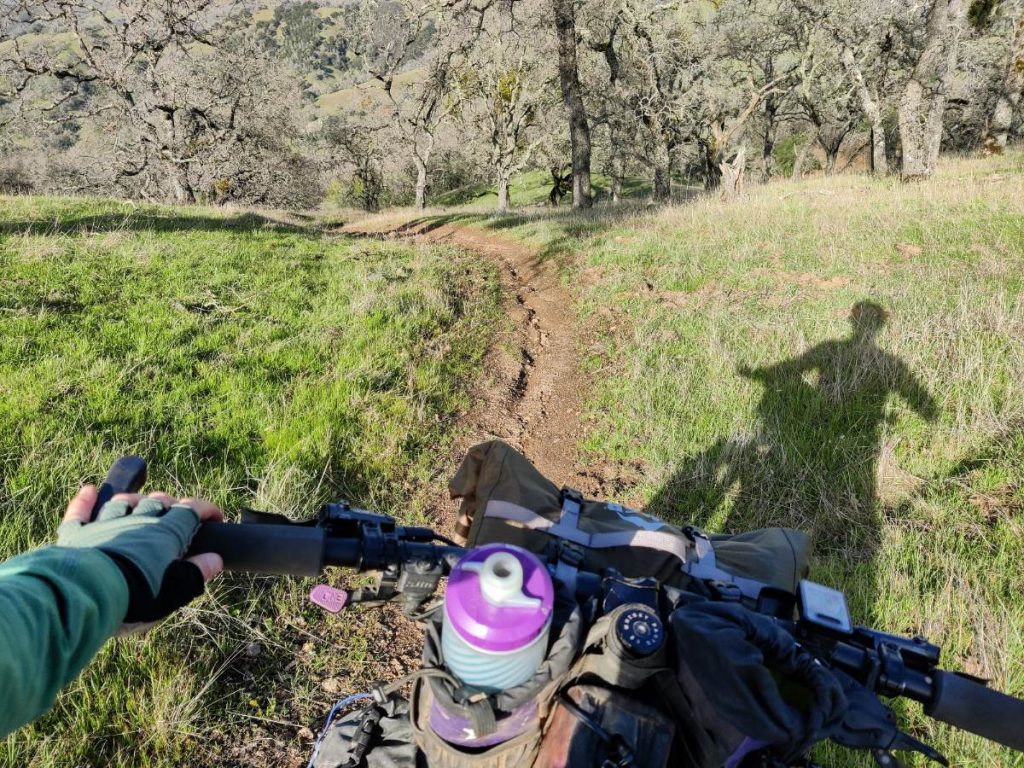
Testing the Hubba Hubba’s handlebar bag on some steep singletrack
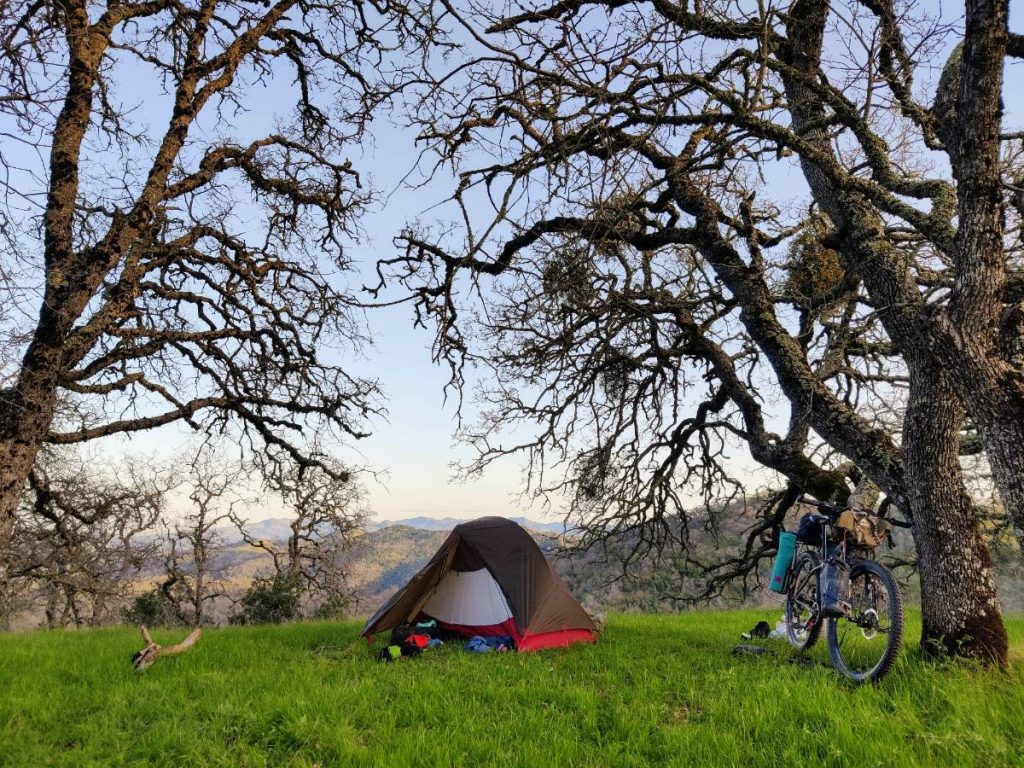
The Hubba Hubba Bikepack 1-Person tent atop a grassy ridge in Henry Coe State Park.
MSR provided this tent for testing and review, but all words and opinions are my own. When you buy through affiliate links in this post, I may earn a small commission. Thanks for your support!
Overview
Product: MSR Hubba Hubba Bikepack 1P Tent
Review summary: MSR’s Hubba Hubba Bikepack is a bikepacking-optimized version of their popular lightweight freestanding tent. In my testing I’ve found it to be a well-rounded choice that checks all the important boxes. Features distinguishing it from the competition include an excellent handlebar-mountable storage bag, warm and sheltered inner, true rectangular floor, and straight zippers that should prove very durable.
Price: $500
Packed weight: 2 lb 13 oz
Capacity: 1 person (2 person also available)
Peak height: 38″
Dimensions: 30″ wide x 85″ tall
Color: dark green fly, white and red inner
My rating: 4.5 out of 5 stars, solid choice with some unique advantages and a couple contextual drawbacks
Shop Hubba Hubba Bikepack Tent at:
What I love about the Hubba Hubba Bikepack tent:
- Excellent handlebar-mountable storage bag
- Freestanding structure (only vestibule needs a stake)
- Easy and quick setup
- Cozy and warm thanks to less mesh and more fabric on inner walls
- Ample pockets and clothes lines for staying organized
- Uses only straight zippers, which are less likely to wear out prematurely
Could be better:
- Not the roomiest in its category (though totally adequate)
- Not enough airflow through inner walls for really hot climates
- Not fully stealthy, especially without fly
The Case for a Bikepacking-Specific Tent
MSR’s Hubba Hubba is a bikepacking-specific version of their popular Hubba Hubba backpacking tent. As such it has shorter poles (making it easier to fit on a bike), a stealthier green rainfly (for subtle camping near to civilization), and the best bikepacking-specific storage bag I’ve seen.
Does a tent need to be a “bikepacking tent” to be used for bikepacking? Definitely not. In fact, many of the most popular tents among bikepackers are simply backpacking tents. The most important factors, like light weight, durable materials, and livable design, are common among both categories.
That said, I love that tent makers like MSR are getting on the bikepacking bandwagon and optimizing their tents for pedal-powered campers. In the absence of a particular reason to choose something else — perhaps a focus on ultralight weight or a specific style of riding and camping — bikepacking-specific tents make a great default choice that’s likely to work with a wide variety of bikepacking setups.
Related: How to Pack for Bikepacking: What Goes Where?

The Hubba Hubba Bikepack’s short poles fold down to less than 12″ long, making them easier to find a spot for in a bikepacking setup.
Freestanding Design
The Hubba Hubba, like many popular bikepacking tents, is freestanding. This means the basic structure doesn’t require any stakes, though they’re nice to use when possible for extra stability. The vestibule does require a stake (or something to tie the corner to, like your bike perhaps). It’s nice to stake out the opposite side for ventilation, but not required.
In my experience, freestanding tents are much more important for bikepacking than for backpacking. Bikepackers are more likely to find ourselves pitching up in more populated areas where dirt isn’t the only surface. While bikepacking I’ve pitched my tent in parking lots, on porches, inside abandoned buildings, and plenty of other spots where tent stakes aren’t an option. So the Hubba Hubba’s freestanding design is a definite plus for bikepacking.
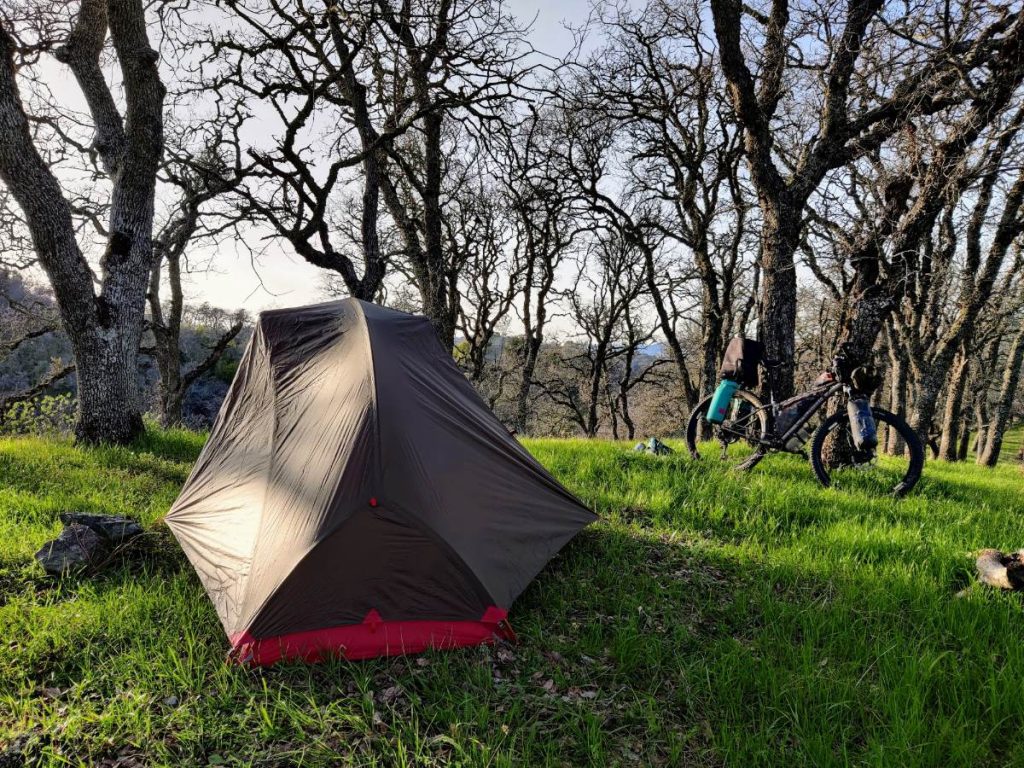
The Hubba Hubba’s four corners are attached to pole tips, so only two stakes are needed for the long sides (and those are technically optional).
Living Space
When it comes to interior space the Hubba Hubba is fairly typical for a solo tent, which is to say adequate for most people but a bit snug if you’re a bigger person. The peak height is a standard 38″ and the interior length is 85″, both of which are on the smaller end of the standard spectrum (see the Closest Competitors section below for details).
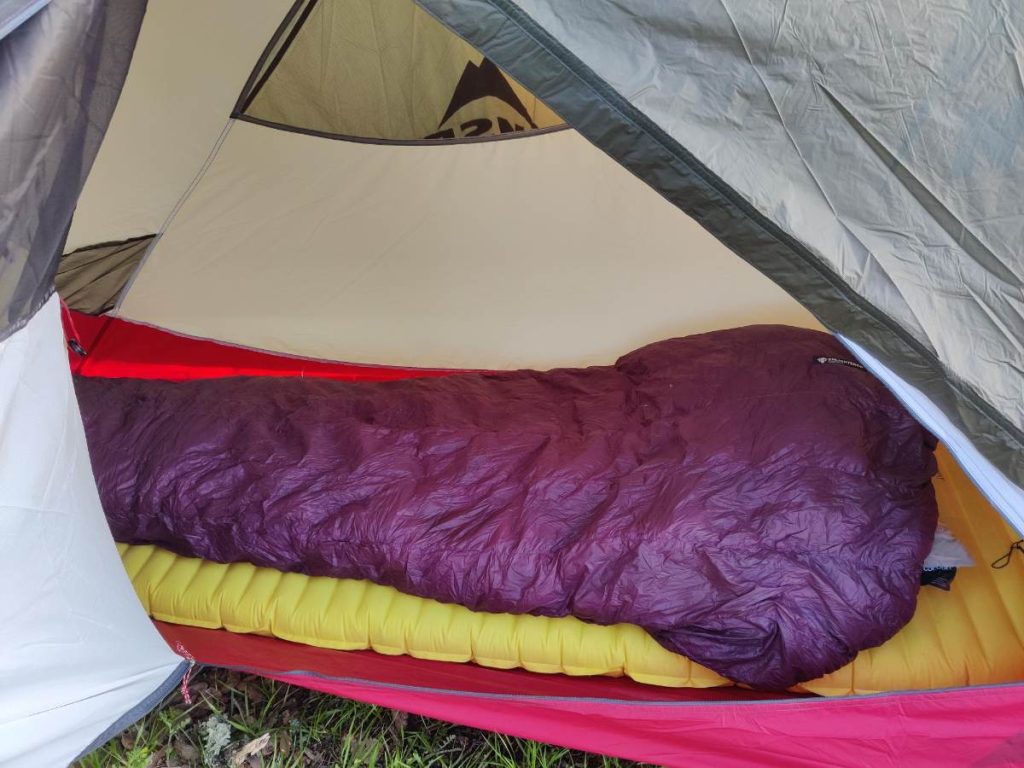
The side door is roomy and easy to get in and out through.
That said, the difference is small (the roomiest competitors are only 3 inches longer) and the Hubba Hubba is a fine size for all but the tallest or largest people. For me, at 5’5″ height, there is ample space to stretch out. The short cross pole at the peak makes for a reasonably roomy spot to sit up inside. The Vestibule is big, with plenty of space to stash gear and cook (carefully, and not in bear country!) in the rain.

The vestibule is plenty big for stashing gear, helmet, and shoes.
Uniquely, the Hubba Hubba’s floor is a true rectangle. Most of its competitors use a trapezoidal floor shape which tapers from head to feet. A tapered shape gives more space for gear at the head, but correspondingly less space at the foot end. Depending on your preferences, one may be better than the other. I’ve used both and don’t have a strong preference either way.
The Hubba Hubba has a single side door, a common feature on many but not all solo tents. Personally I don’t mind a front door either, but I admit the Hubba Hubba’s roomy side entrance is particularly easy to enter and exit.
Pockets, Lofts, and Lines
The Hubba Hubba Bikepack is full of useful yet lightweight features to help keep things organized. In my experience, when you’re on the road for awhile these kinds of small touches make a surprisingly big difference.
There are two mesh pockets down near the floor, one at the head and one at the foot. At the head I like to keep my phone, headlamp, and other small items I use during the night. The pocket at the foot is perfect for drying my stinky wet socks. 🙂
Overhead, at the peak, is a veritable laundry room. The triangular mesh gear loft is handy for holding more small items or drying small accessories. The web of lightweight guy line strung along the edges is great for hanging wet clothes to dry overnight.
The tent also comes with several more lines to string up on the outside, again for drying clothes. It’s as if someone told MSR that bikepackers are a sweaty bunch, always hanging our grungy wet clothes and chamois shorts anywhere we can find (ok, guilty…). Given that we sometimes travel on our bikes for months at a time and “do laundry” in the sink, I suppose this is fair.
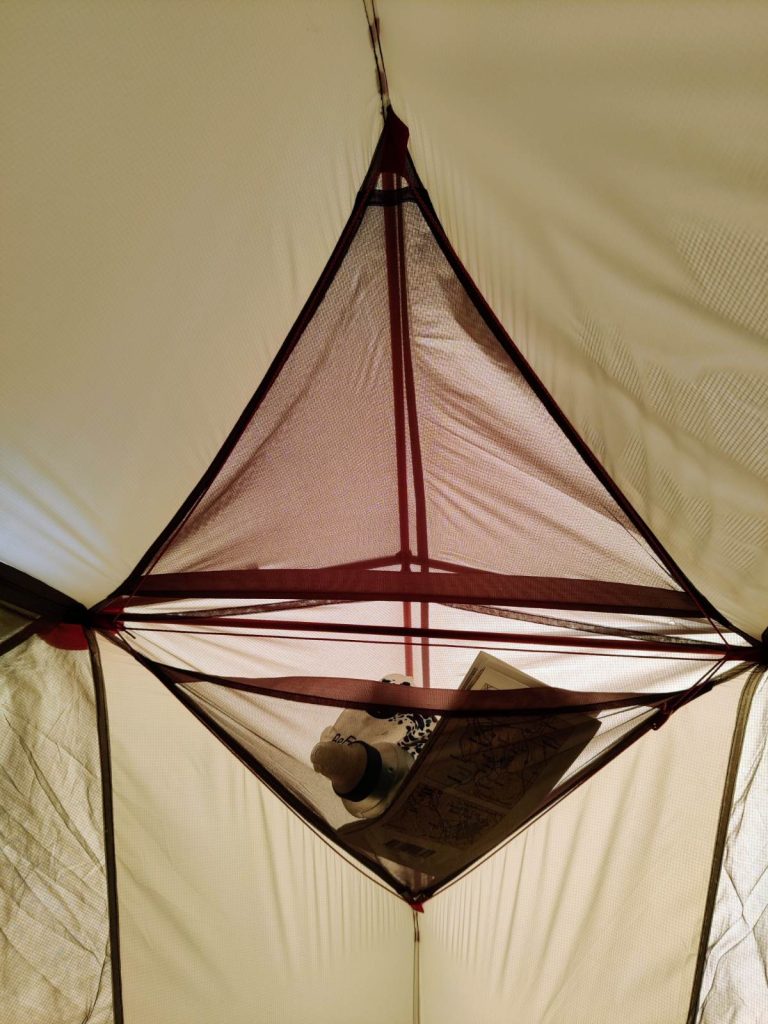
Looking straight up at the central gear loft and clothes lines
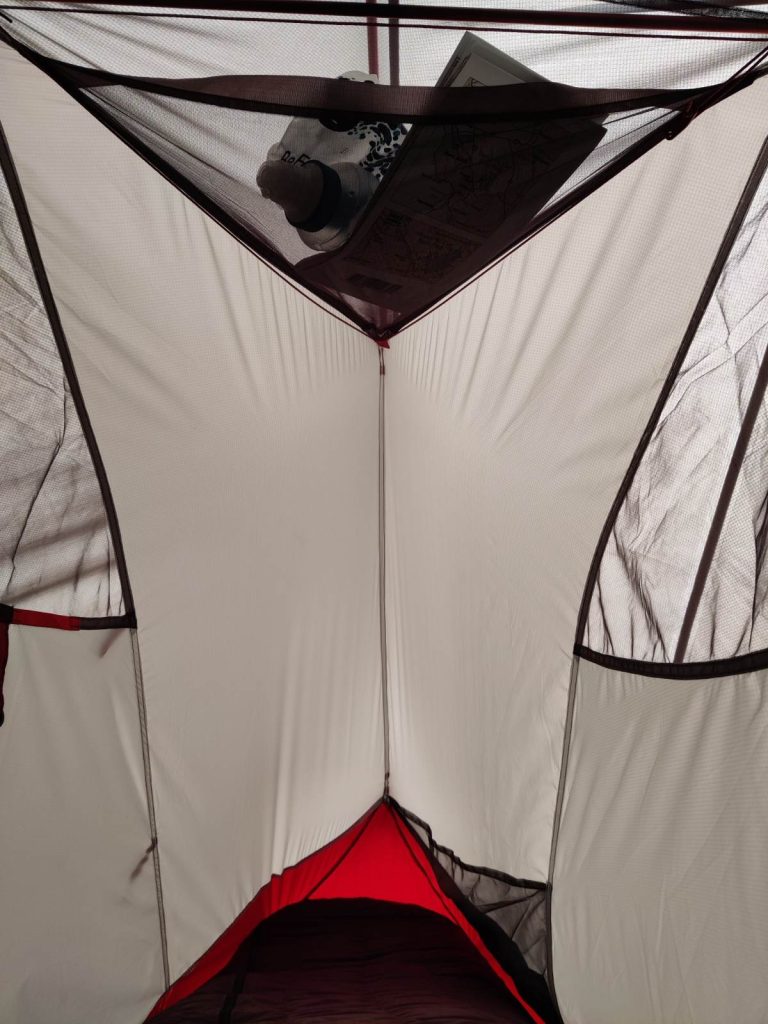
Looking toward the foot of the tent, with side pocket on bottom right and gear loft at upper edge.
Weight
The Hubba Hubba Bikepack’s weight is in line with its closest competitors, other lightweight freestanding tents like the Copper Spur and NEMO Dragonfly bikepack models. It’s a bit heavier than the Big Sky Soul, a more minimalist bikepacking-specific tent with less robust storage bag. It’s considerably heavier than truly ultralight shelters like the Zpacks Plex Solo, but these are in a different category (single wall, not freestanding, more expensive). Overall the Hubba Hubba aims to check all the boxes for functionality and durability at the lightest feasible weight.
The entire package has a claimed packed weight of 2 lbs 13 oz, which matches what I see on my scale. This includes the handlebar storage bag, which is more durable and fully featured than a typical stuff sack and weighs nearly 8 ounces just by itself. If you have another place to carry your tent and care about shaving ounces from your setup, the tent + poles + stakes alone weigh a respectable 2 lbs 6 oz.
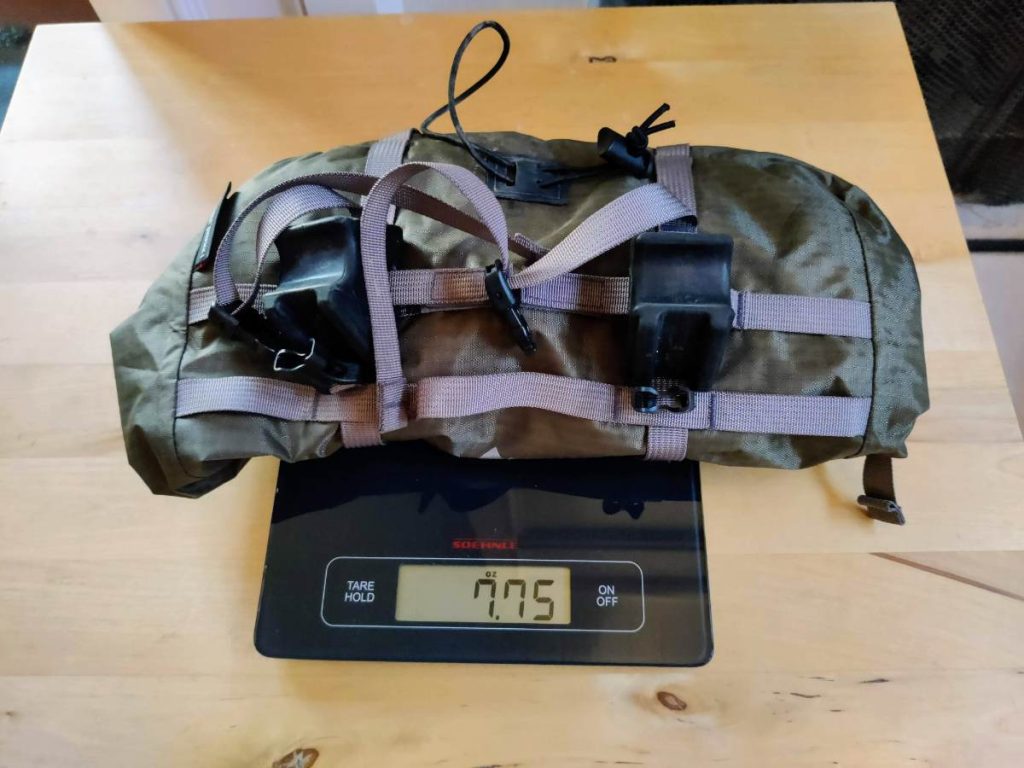
The handlebar bag is heavier than a typical stuff sack at almost 8 ounces.
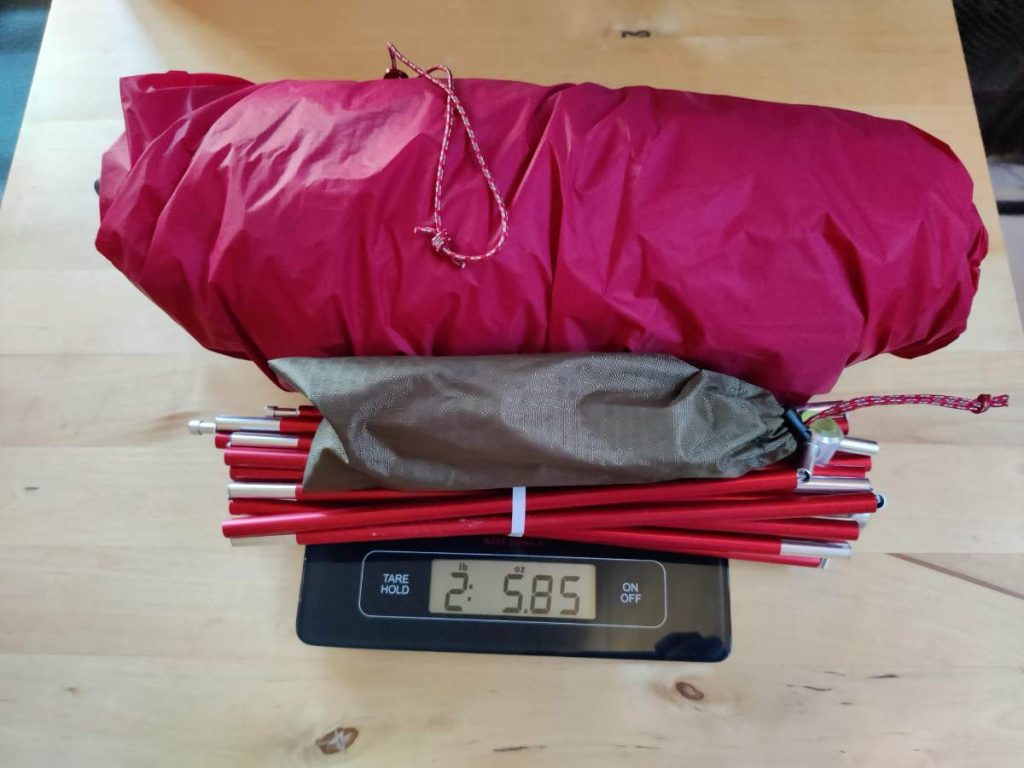
If you don’t need the handlebar bag, the tent + poles + stakes weigh 2 lbs 6 oz.
Setup and Takedown
The Hubba Hubba bikepack is an easy and intuitive tent to set up. It took me about 5 minutes at camp with no instructions. (I always recommend you do a test setup at home first. Do as I say, not as I do!).
Because it’s freestanding, the setup is very straightforward and you don’t need to spend much time fussing with stakes and guy lines. The entire structure is supported by a single continuous pole, plus one short cross pole at the peak for width. There’s really no way possible way to get it wrong.
The process is simple and familiar: first unfold the poles, slip each corner into the metal fittings, and clip the inner onto the poles. Attach the top cross pole. Then spread the fly over the top, slipping the metal fittings onto the pole bottoms. Two stakes on each of the long sides finish the setup.
Takedown is just as simple and fast, and thanks to the roomy storage bag (see below) the rolling and packing process is as easy as it gets.
Mesh and Fabric Inner
Compared to other tents of similar design (see Closest Competitors below) the Hubba Hubba bikepack has less mesh and more fabric on its inner structure. This makes it especially warm and cozy for a 3-season tent, which is great if you usually bikepack in alpine environments or cool and windy conditions. During my bikepacking trip in early March the nights were still chilly and the Hubba Hubba kept me warmer than I expected.
The drawback, on the other hand, is less ventilation in warm climates. When bikepacking in hot places like Morocco, Sudan, and Southeast Asia I’ve really appreciated a tent with mostly mesh inner walls. The Hubba Hubba’s inner would not work well alone as mosquito protection in tropical climates, but that’s obviously a less common use case for most bikepackers.
On the other-other-hand, the Hubba Hubba’s fabric-heavy inner does provide more privacy when used without the fly. If you’re camping in a place where privacy is important, this makes it feasible to leave the rainfly off. This setup would certainly be cooler and better ventilated than a tent with mostly mesh inner but the rainfly on for privacy.
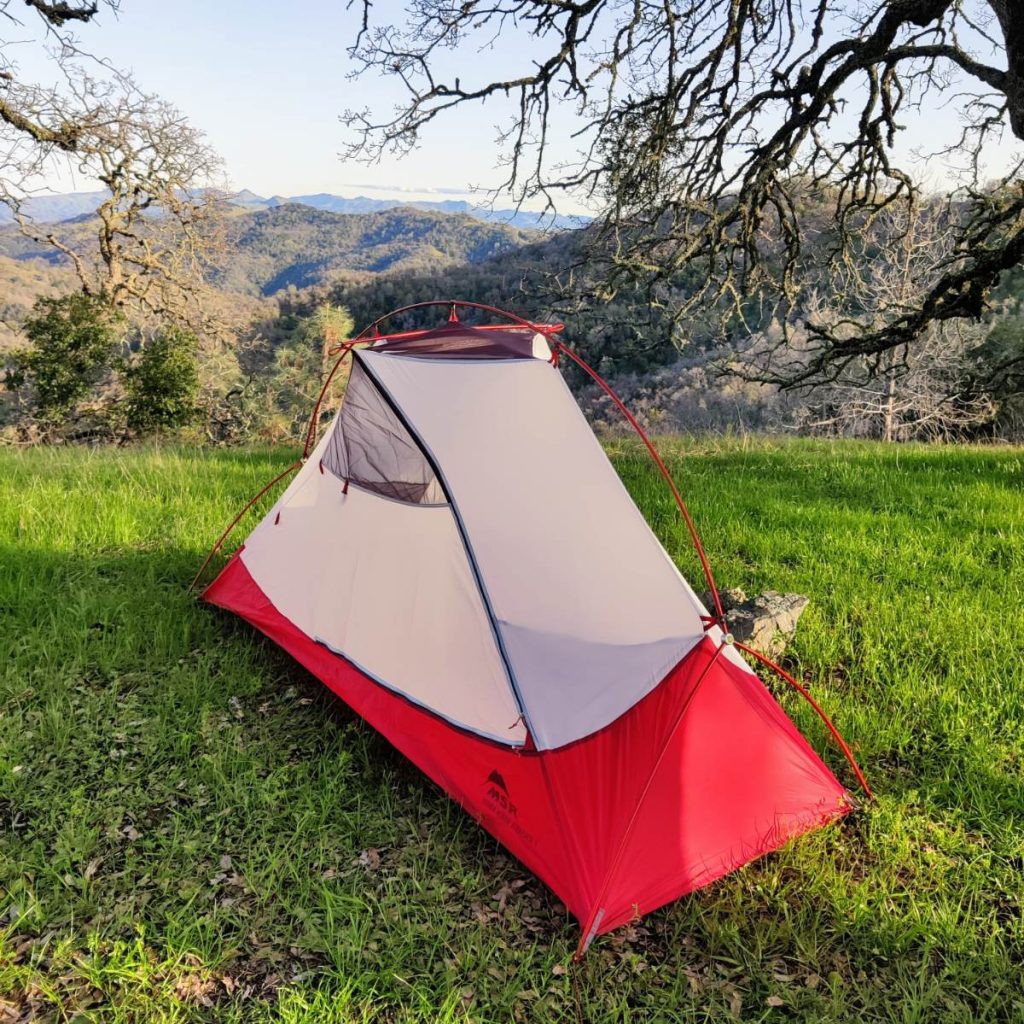
The Hubba Hubba’s inner has more fabric and less mesh than most solo tents, making it better for cooler climates than hot ones.
I’m a big fan of MSR’s decision to use only straight zippers on the Hubba Hubba’s inner! Unfortunately I’ve learned from experience that curved zippers are often the first part of a shelter to wear out, and they can’t always be repaired or replaced. This thoughtful touch should help the Hubba Hubba last for many years, possibly more than its competitors.
Weather Protection
I’m still waiting for the “opportunity” to test the Hubba Hubba in a raging storm. In the meantime, it seems about as storm-worthy as a typical 3-season tent. The freestanding design is helpful in wind — less worry about stakes pulling out — and the shape should do a decent job of breaking wind if oriented with the short side into the blast.
As mentioned above, the unusual amount of fabric on the inner walls makes for an especially warm and cozy tent. One of my nights in the Hubba Hubba was especially windy and the early March temps were chilly, but I felt warmer than expected.
Related: Tips for Bikepacking in the Rain
Ventilation and Condensation
The Hubba Hubba is a double walled tent, the best style for managing interior condensation, and it does this quite well. I spent a very dewy night in the Hubba Hubba and woke to a very wet fly, but had zero issues with condensation or drips inside.
The inner is well-ventilated at the top and the fly has a small vent that can be propped open at the top of the door zipper. Seemingly minor detail, but the door-keeper loops are refreshingly easy to use (even one-handed) if you want to open the fly for extra air flow.
Handlebar Bag
In my opinion the Hubba Hubba comes with the best bikepacking-specific storage bag of any solo tent. I mean, there’s a reason bikepackers pay good money for specially designed handlebar harnesses: it’s a hard item to get right even when that’s the primary focus. The Hubba Hubba’s bag can’t compete with purpose-built solutions like Revelate Designs’ Handlebar Harness, but for a bonus item that comes with your tent it’s pretty darn good.
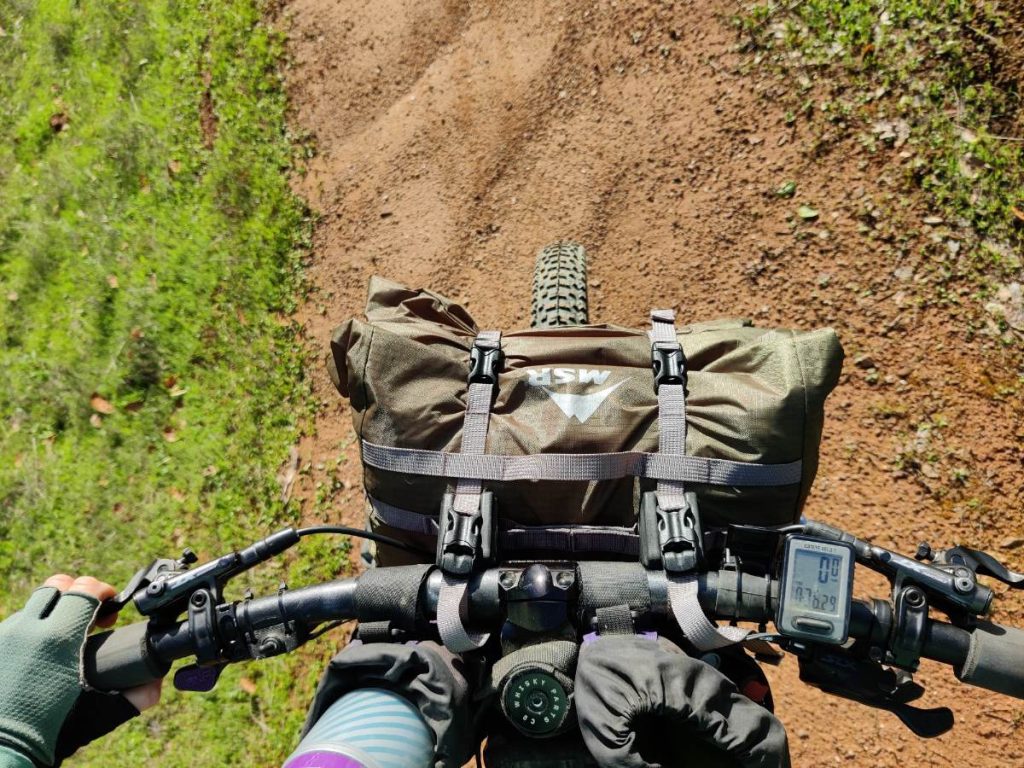
The Hubba Hubba Bikepack’s included handlebar bag is surprisingly good for a glorified tent stuff sack.
The Hubba Hubba’s handlebar bag was clearly designed by people who actually know about bikepacking. Unique among its tent competitors, it includes optional spacers that sit against your handlebars and hold the bag off your cables and out of the way of your handlebar-mounted gadgets. I was impressed by how stable this simple system was, even on rough singletrack. The headtube bungee is less robust and I wouldn’t necessarily trust it to hold up on a long rugged trip, but it should be possible to replace the bungee with a stronger strap if needed.
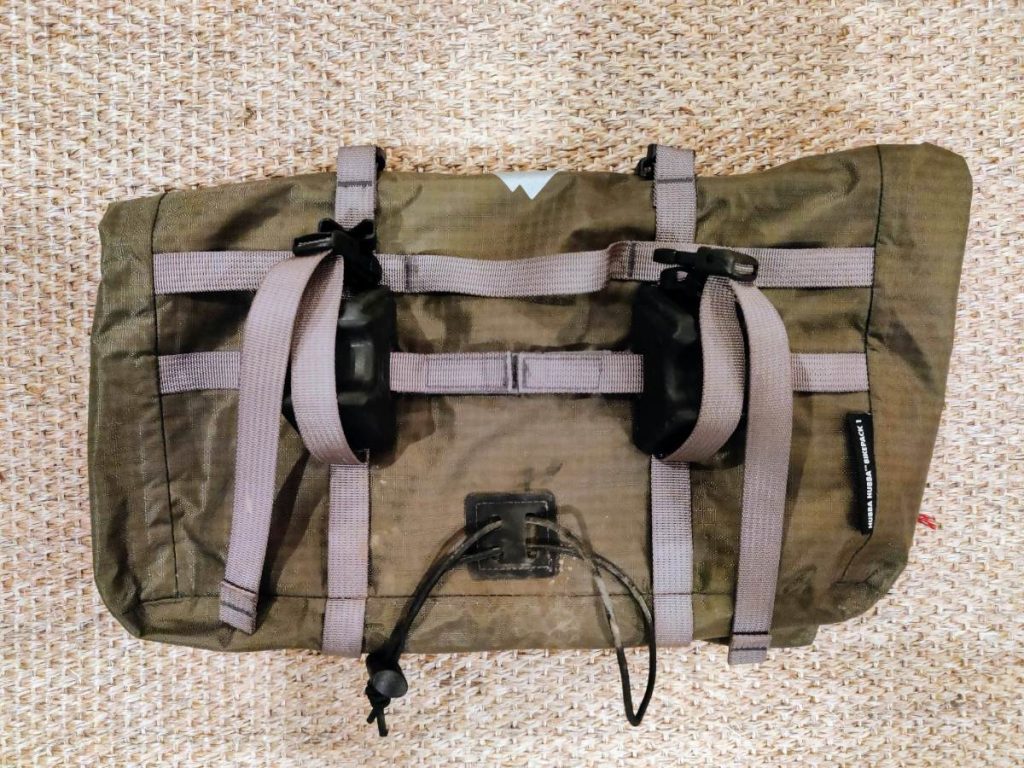
The back of the storage bag has two optional spacers and handlebar straps (nicely done) plus a minimalist headtube bungee (not quite robust enough for extended rough riding, in my opinion).
The bag measures about 14 inches wide and the pole bundle is even shorter, around 11 inches. This means the entire package can even be carried on drop handlebars, solving a classic conundrum for bikepackers with longer tent poles. Though I’ve mostly been testing the Hubba Hubba Bikepack on my flat bar mountain bike, the bag fits easily on my drop bar Salsa Fargo as well.
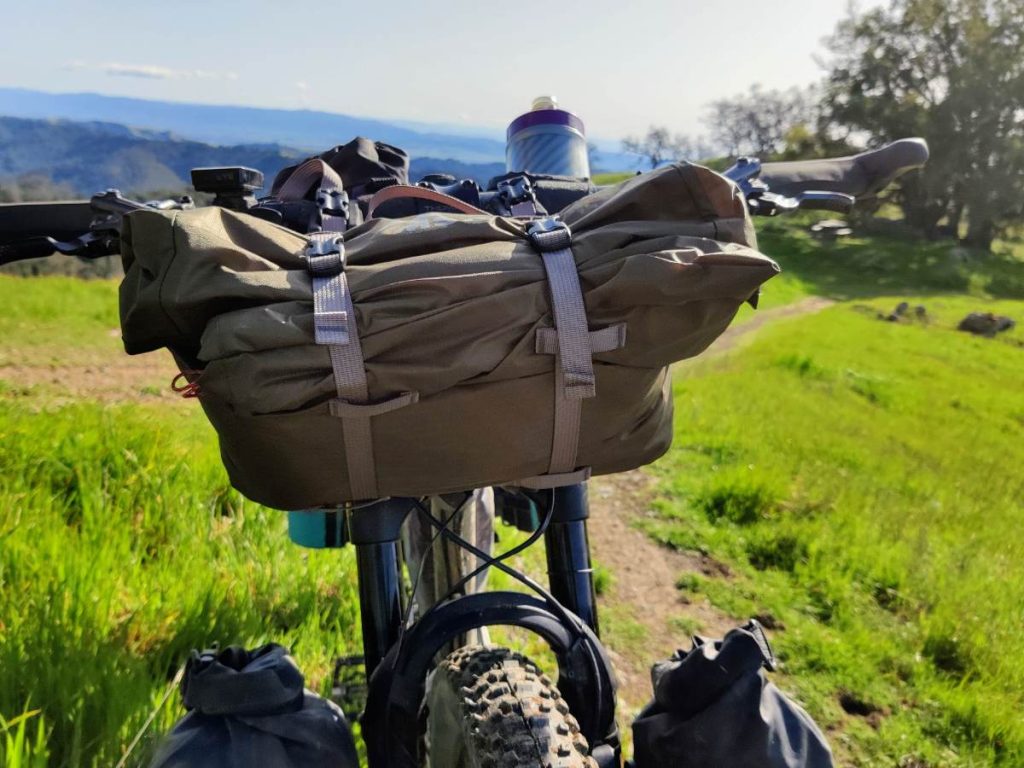
The storage bag has two parts: the main compartment and a separate pole pouch. They work well together, but it’s nice to have the option of separating them if you want to pack the poles somewhere else or (in the case of the 2-person model) share the load with a partner. Both parts are a durable fabric, perfect for withstanding the occasional tire buzz or overgrown trail.
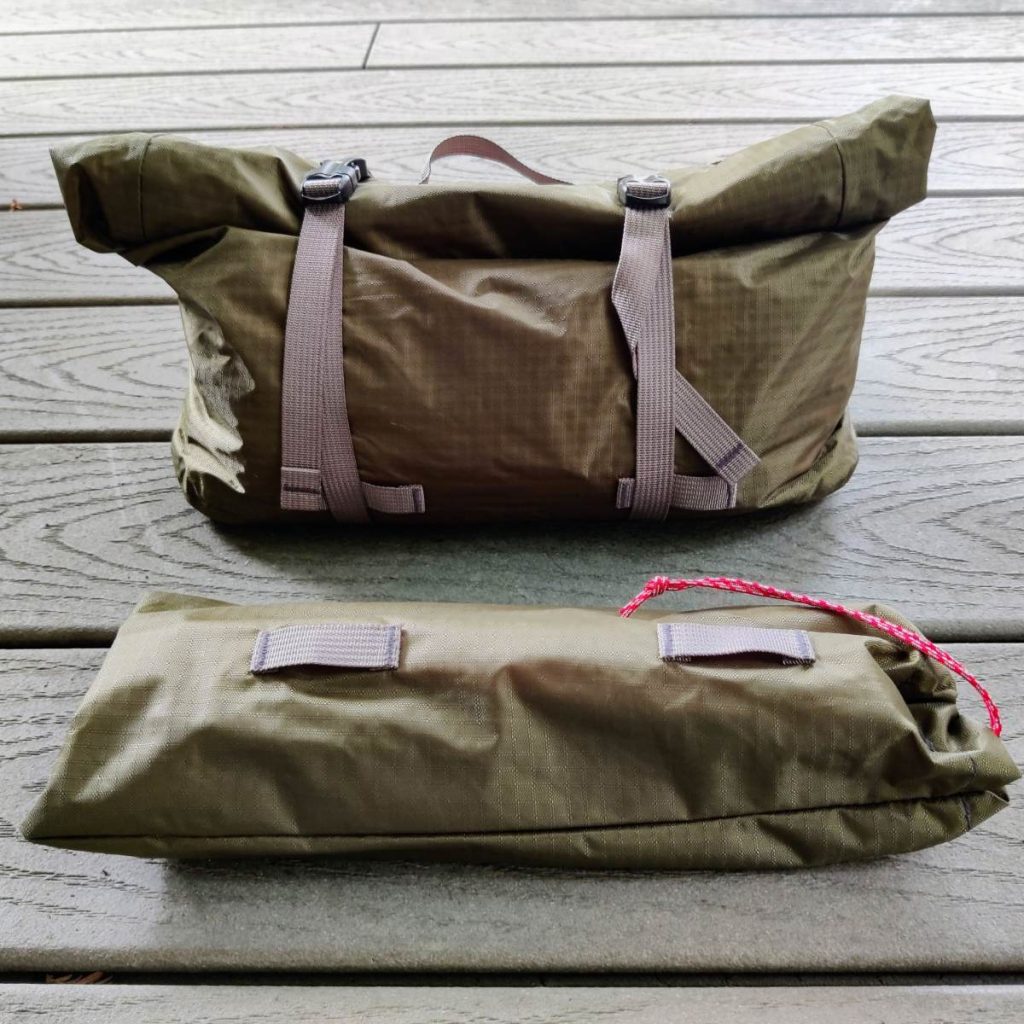
The pole pouch is separate from the main compartment but can easily be attached with straps.
The roomy roll-top main compartment makes for fuss-free packing, which is lovely because no one likes starting every morning by wrestling a tent into a tight stuff sack. I had to pack my tent up damp one morning and the loose fit of the storage bag made it easier. It was even big enough to hold my inflatable sleeping pad in addition to the tent, saving me space elsewhere in my bikepacking bags.
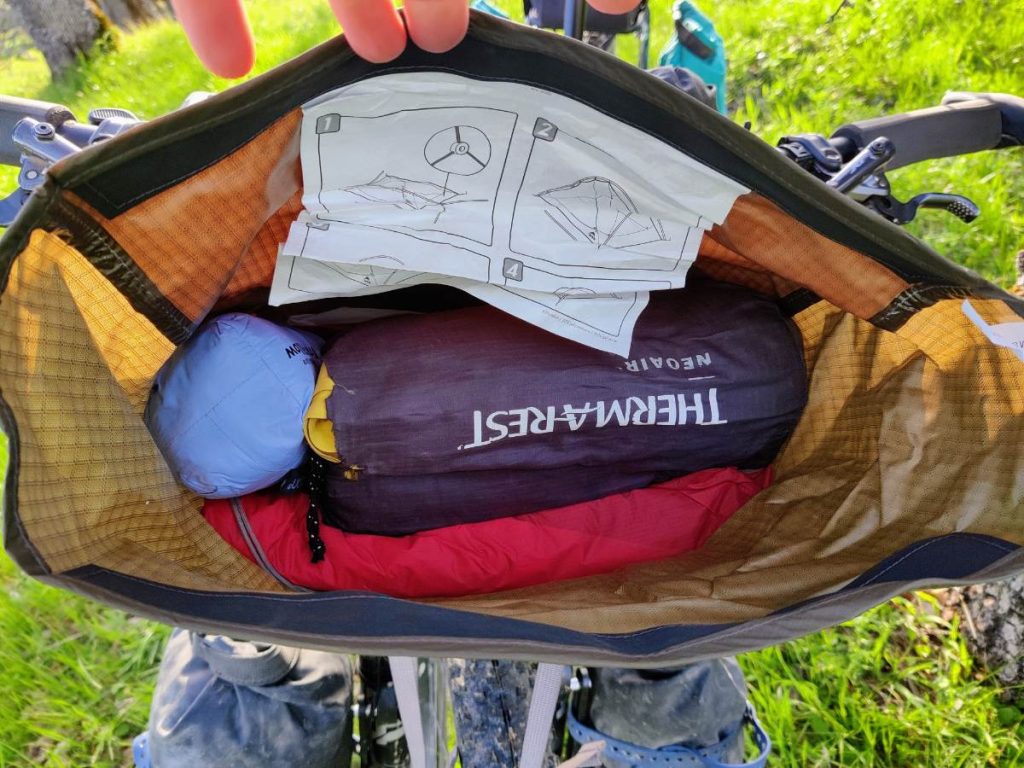
The handlebar bag can easily fit the tent plus an inflatable sleeping pad or other light items, making it a useful addition to a bikepacking bag collection.
I would trust the Hubba Hubba’s handlebar bag on pavement and gravel, even for longer trips. I’m not convinced it would hold up to extended rough singletrack riding, at least not without replacing the headtube bungee. And I wouldn’t want to double up — like strap a sleeping bag to it — for a rough ride because there would be too much bouncing.
The storage bag is a nice bonus for folks who don’t already have a handlebar harness, but what if you do? I often carry both a sleeping bag and a tent in my handlebar harness, and the Hubba Hubba’s bag isn’t big or robust enough to replace my current system.
In this case you can remove the optional spacers and separate pole pouch, roll the tent around its poles, and use the main storage compartment as a stuff sack. It’s a tiny bit heavier than necessary due to the buckles and straps, but not enough to matter for most people.
Overall, the Hubba Hubba Bikepack’s handlebar bag is a nice bonus if you don’t already have one, and can also be adapted to work with whatever system you already use.
Color and Stealthiness
When MSR created the bikepacking version of the Hubba Hubba, they changed the fly color from the original tan to a deep green. Great move! When bikepacking, much more-so than backpacking, it’s common to pitch near populated areas or roads where we’d rather not be noticed.
I actually wish MSR had gone even further with the stealth redesign. There are still some red accents on the fly, and if it’s too hot for the fly the red and white inner is extremely un-stealthy. I prefer my bikepacking tents to be entirely green, ideally a lighter sage-green color that can blend into both forest and desert environments. I’m a women who’s done a lot of solo bikepacking, so this concern may weigh more heavily on my mind than it does for others.

The bikepacking-specific Hubba Hubba’s dark green fly is a nice touch, but it’s still not stealthy enough for my taste due to the white and red inner.
Closest Competitors
In the category of solo bikepacking-specific tents, the Hubba Hubba has just a few competitors. Here’s a quick comparison of their basic stats:
Also worth a mention is the Sea to Summit Telos Bikepack tent, but it’s only available in 2 and 3 person sizes so we can’t compare it directly to the Hubba Hubba 1P.
Of those competitors, the Big Agnes and NEMO are most similar to the Hubba Hubba in design and features. The Big Sky Soul, one of my long-time favorites (see review here) takes a more minimalist approach that’s reflected in its lighter weight and lower price.
Priced at $500, the Hubba Hubba Bikepack 1P is very much in line with its most similar competitors. It’s an especially great value if you don’t already have a handlebar carrying system, because it comes with a surprisingly good one. It’s neither the roomiest nor the lightest option, but it’s well thought-out and should last a long time. Overall it checks all the boxes for a solid, can’t-go-wrong choice for most bikepackers.
More Bikepacking Resources
If you liked this post, you might also like these:
Or visit the bikepacking section for lots more!
About the Author
Hi there, I’m Alissa, founder of Exploring Wild. I’ve traveled over 19,000 miles by bike and still can’t stop planning my next ride (and helping you plan yours). Pavement and panniers or singletrack and seat bag, I love it all. On my bike I feel free. Learn more about me here.
Shop Bikepacking Resources
Bike resources in your inbox?
There’s more where this came from! Sign up here for occasional emails full of inspiration and information about bikepacking and bicycle touring.
Share the Adventure
If you found this article helpful, please consider sharing so more people can benefit from it:
The post MSR’s New Hubba Hubba Bikepack Tent, Tested and Reviewed appeared first on Exploring Wild.
https://exploringwild.com/msr-hubba-hubba-bikepack-tent-review/?utm_source=rss&utm_medium=rss&utm_campaign=msr-hubba-hubba-bikepack-tent-review
 CampingSurvivalistHuntingFishingExploringHikingPrivacy PolicyTerms And Conditions
CampingSurvivalistHuntingFishingExploringHikingPrivacy PolicyTerms And Conditions
